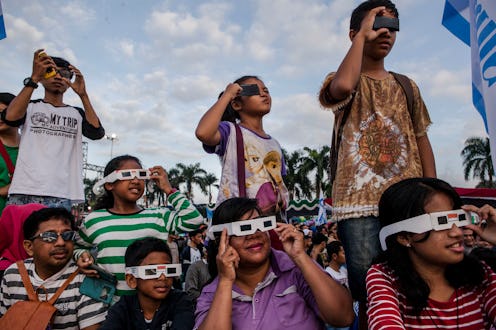Life
When To See The Solar Eclipse So You Don't Miss Any Second Of This Rare Event

On Monday, Aug. 21, we'll experience the first total solar eclipse over the American mainland in 38 years. The sight will literally be spectacular and astronomical — two words that aren't generally thrown around lightly. But trust me, they're worth using now. But, seeing the eclipse isn't actually as easy as just stepping outside and winging it. If you want to know when the best time to watch the 2017 solar eclipse is, you'll first have to figure out where you're watching from.
First of all, the eclipse will occur at different times in different parts of the country, and depending on where you located, you'll either see a full or partial eclipse. If you want to see a full eclipse, you'll need to be in one of the following states that fall within the path of totality: Oregon, Idaho, Wyoming, Nebraska, Kansas, Missouri, Illinois, Tennessee, Georgia, South Carolina, or North Carolina (here's a useful map from NASA that specifies where in each of these states). If you can make your way to one of those states, your eclipse experience will start around 10 a.m. and end close to 3 p.m., with the full eclipse lasting about two minutes. So, plan for a full day of eclipse celebrations. Here's a list of times for the lucky ones in the path of totality:
If you're not in one of those states, you won't be able to see a full eclipse, because you're not in the path of totality. But, don't feel left out! Most of the country will be in the partial eclipse territory, and the states that are in the path of totality are expecting to experience major crowding and epic traffic with their populations doubling or even tripling for the day. So, while it might be a cool sight to see, it might also be incredibly chaotic. If you're outside of the path of totality, just try to enjoy the peace and quiet that comes with a slightly less enchanting celestial experience. I promise it will still be awesome.
Here's the path the eclipse will take, and a map to indicate what type of eclipse you'll see from where you are. You'll notice that even people who live on the outskirts of the path will still get some pretty sweet moon-over-sun action:
To get your exact call time for sky gazing, you'll want to head over to Time's Solar Eclipse Map. They've put together eclipse view prediction chart that takes your zip code, and the mathematical genius of Barry Carter, and tells you exactly what time to get outside, and gives you a preview of what's to come.
Just make sure that if you plan on going outside, you have protective eyewear on that is made for looking at eclipses. Looking at the sun during the eclipse can cause irreparable damage to the eye, so don't mess around. Head to Amazon and order yourself a pair of NASA-approved eclipse glasses that meet the ISO standard of ISO 12312-2.
Happy sungazing!